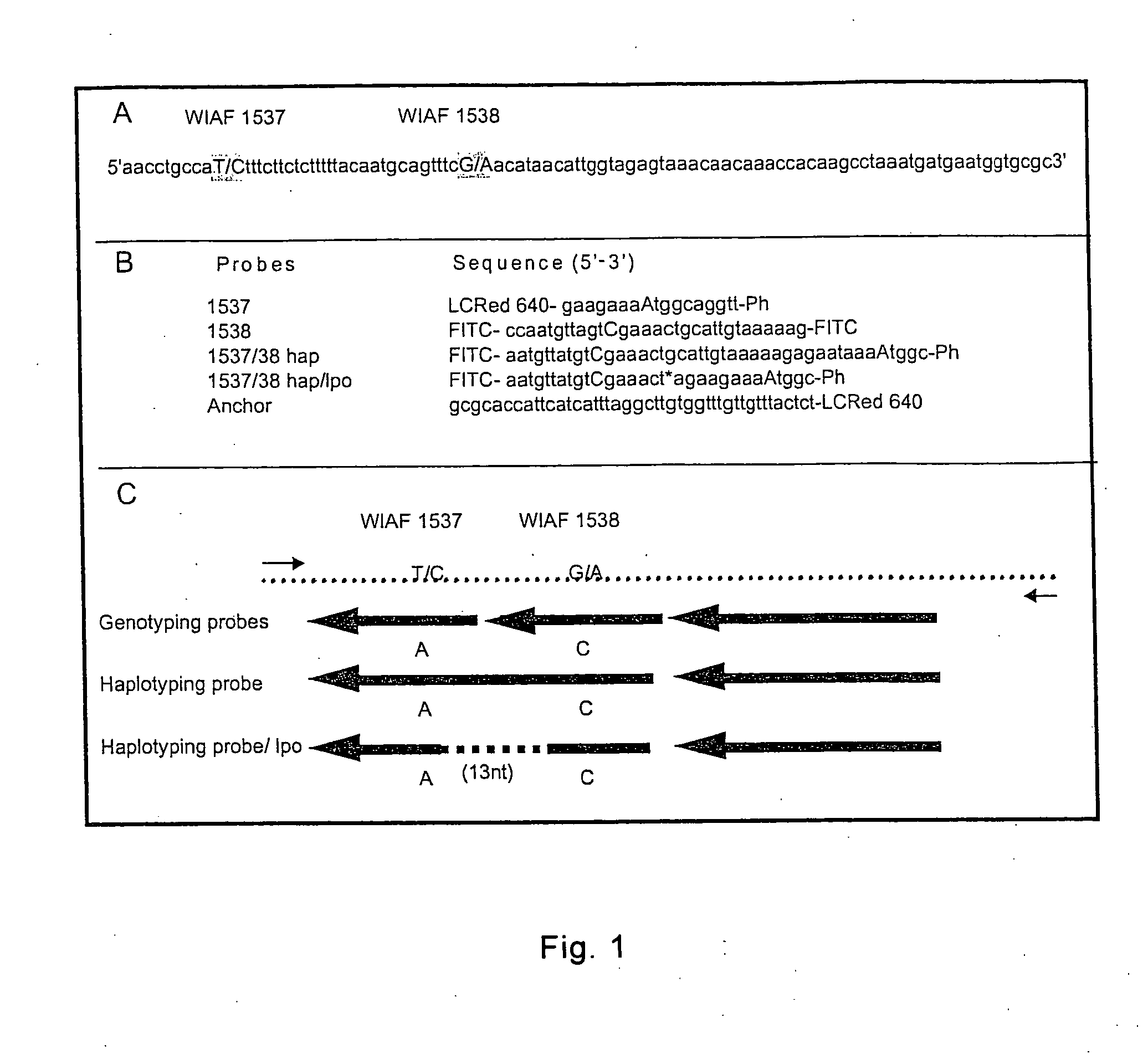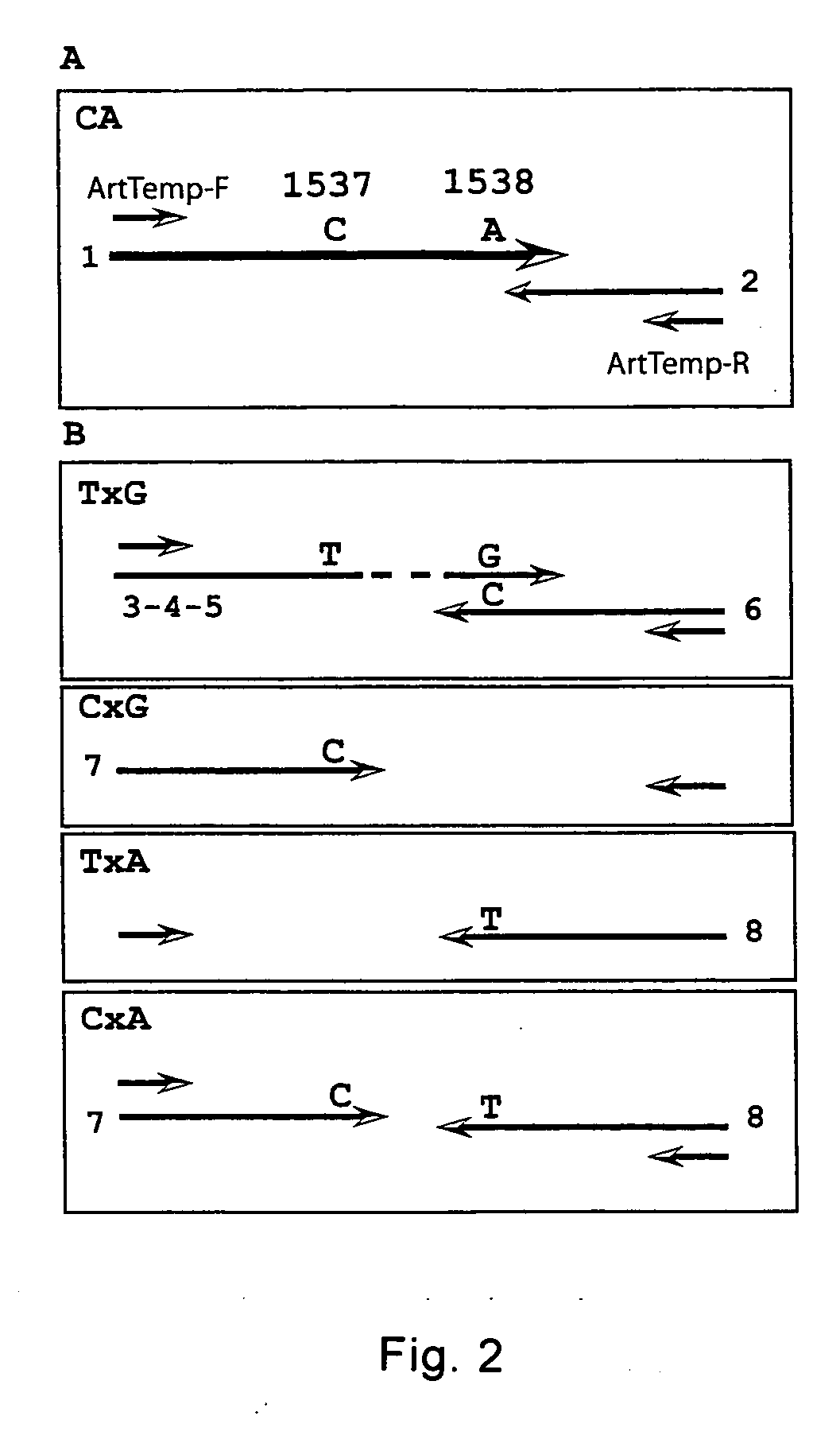Method for haplotyping and genotyping by melting curve analysis of hybridization probes
- Summary
- Abstract
- Description
- Claims
- Application Information
AI Technical Summary
Benefits of technology
Problems solved by technology
Method used
Image
Examples
example 1
Haplotyping SNPs
[0176] The utility of the method, nucleic acid probe and probe / template complex of the present invention is illustrated in the following example, which shows that two SNPs from chromosome 21 can be haplotyped using melting curve analysis of nucleic acid hybridization probes. The first probe covers both SNPs of interest and the second one has a sequence deleted between the 2 SNPs compared to the template allowing haplotyping of SNPs further apart. Using series of “artificial” templates with increasing distance between 2 SNPs it is demonstrated that a hybridization probe will still melt as a unit and discriminates the 4 haplotypes even when the distance between SNPs is 87 nucleotides. The additional sequences (13 nucleotides to 72 nucleotides, depending on the template) must loop out or bulge to allow probe binding to the template.
[0177] SNPs Selection, Primers and FRET Probes
[0178] The two SNPs WIAF-1537 and WIAF-1538 on chromosome 21 were selected from the Whitehe...
example 2
Haplotyping SNPS in Close Proximity
[0197] The following example further illustrates the utility of the methods and materials of the present invention in haplotyping SNPs in close proximity. The assay described below uses properties of melting temperatures of hybridization probes covering two SNPs of interest to haplotype the beta 2 adrenergic receptor (B2AR) gene. B2AR encodes for a G protein coupled receptor that mediates the action of catecholamines and is the target for beta-agonist and beta-blockers involved in the treatment for asthma and congestive heart failure. Twelve haplotypes have been described in the human population using 13 SNPs distributed along the gene. Different drug responses have been associated with the different haplotypes (Drysdale et al., Proc Natl Acad Sci USA 97(19):10483-8 (2000)). The three most common haplotypes are distinguishable by SNPs at position −20, +46 and +79 (FIGS. 6A and 6B). Two haplotyping probe sets were designed. One overlaps the −20 / +46...
example 3
Haplotvping of the B2AR Receptor Gene
[0208] A loop out probe hybridizing with the 3 SNPs at position −20, 46 and 79 of the B2AR receptor gene was created to test the possibility of haplotyping 3 SNPs in one experiment with two sequences from the template looped out (FIG. 7A). This probe is labeled at both ends with a FITC fluorophore. It is anchored on the −20 SNP side by an oligonucleotide labeled in 3′ with LCred640 and on the 79 SNP side by an oligonucleotide labeled in 5′ with LCred705 (FIG. 7B). Melting temperature of this probe in determined both in the F2 channel (LCred640, −20 SNP side) and the F3 channel (LCred705, 79 SNP side). The probe was tested on 3 samples, each carrying 2 chromosomes with the haplotype 2 or the haplotype 4 or the haplotype 6 (FIG. 7C). Nucleotides in the probe are a perfect match with the haplotype 2, are mismatched in 2 positions with haplotype 6 and at 3 positions with haplotype 4. Data (FIGS. 7D & 7E) shows single melting curves in both channels....
PUM
 Login to View More
Login to View More Abstract
Description
Claims
Application Information
 Login to View More
Login to View More - R&D
- Intellectual Property
- Life Sciences
- Materials
- Tech Scout
- Unparalleled Data Quality
- Higher Quality Content
- 60% Fewer Hallucinations
Browse by: Latest US Patents, China's latest patents, Technical Efficacy Thesaurus, Application Domain, Technology Topic, Popular Technical Reports.
© 2025 PatSnap. All rights reserved.Legal|Privacy policy|Modern Slavery Act Transparency Statement|Sitemap|About US| Contact US: help@patsnap.com



